Academic Papers

Authors and co-authors: Toshihiko Tominaga, Kazuki Takahira, Yusuke Kimura, Ai Tojo, Eiichiro Tada, Tsutomu Sugaya
Modern Endodontics: In recent years, endodontic treatment is said to have advanced dramatically with the development of various NiTi files and the introduction of dental microscopes and CBCT. However, there has been no significant improvement in the success rate. It is reported that the success rate is approximately 90% for cases in which infection has not progressed to the root apex (extracted root canal), 80-90% for cases in which the root apex is infected and has a root canal lesion (infected root canal), and a dramatic decrease to 60-70% for cases that are re-treated. Furthermore, in a study evaluating the prognosis of extracted root canals, the success rate was reported to be 94.3% for dental radiographs (analog), 92.3% for dental radiographs (digital), and 81.3% for CT images, which is a discrepancy from what we as dentists perceive from the clinical symptoms. This is a discrepancy from what we dentists perceive from clinical symptoms. The causes of failure of extracted root canals with no or minimal infection at the root apex are the spread of infection to the root apex due to careless instrumentation or coronal leakage, infected pulp after scientific or mechanical root canal cleaning, and residual contaminants. Especially in root canals where transportaion (ledge, zip, perforation; Figure 1) is observed, it is very difficult to remove the source of infection by conventional cleaning methods. Furthermore, if the infection extends to collateral root canals such as side branches and bifurcations, or outside the root canal, it often becomes intractable and cannot be treated nonsurgically.

Author/Co-author: Toshihiko Tominaga, Kazuki Takahira, Eiichiro Tada, Tsutomu Sugaya
I. Conventional Endodontics: An important prerequisite for successful endodontic treatment is the removal of infected tissue and contaminants in the root canal. However, the root canal morphology is complex and varied, and it is virtually impossible to remove all pathogenic factors by conventional chemical-mechanical root canal cleaning. In the Toronto study1) , the success rate of initial treatment was 82% in patients with preoperative root canal lesions, lower than 93% in those without, and even lower to 69% in those with transport. When infection spills over into the root apex, where root canal morphology varies widely, many cases cannot be cured by conventional cleaning methods, and the patient often struggles to deal with the zips, ledges, and perforations caused by transpotation (Fig. 1). In cases where infection has progressed beyond the root apex, it is impossible to remove the source of infection on the outer surface of the root, within the root lesion, or within the foreign body outside the root apex, and surgical treatment is the first choice (Figure 2).

Published September 10, 2021 (Quintessence Publishing)
Authors and co-authors: Toshihiko Tominaga, Eiichiro Tada, Kazuki Takahira, Tsutomu Sugaya
Mechanical scientific root canal cleaning is the most important step in root canal therapy. However, there are some root canals that cannot be penetrated into the root apex due to complex anatomy such as root canal curvature, stenosis, bifurcation, repaired dentin, ledge formation, and debris (Figure 1). The success rate of endodontic treatment of non-perforated root canals with apical lesions is only 69% compared to 90% for perforated root canals, and the success rate for retreatment is reported to be as low as 31%. High-frequency electric currents, due to their characteristics, conduct electricity through the root canal regardless of the root canal carrying capacity, and when passing through a stenosis with high electrical resistance, the current density increases and Joule's heat is generated. Furthermore, it has been shown that the electrical discharge in the bubble generated by the heat can cauterize the collagen in the root canal wall and melt the dentin. Panariello et al. reported the anti-biofilm effect of HF on Enterococcus feacalis, and in our study, when HF was applied to a simulated root canal with a biofilm of Actionmyces naeslundii In our study, the disappearance of biofilm was observed when high-frequency electric current was applied to simulated root canals in which Actionmyces naeslundii biofilm was established. In this paper, we present an example of the application of HF energization to a case of non-penetratable apical periodontitis with a root canal lesion using the Root ZX3.

Authors and co-authors: Toshihiko Tominaga, Eiichiro Tada, Kazuki Takahira, Tsutomu Sugaya
We report the case of a 39-year-old male with Persistent Apical Periodontitis (PAP) caused by infection in an uninstrumented area, wherein conventional chemical root canal treatment is not possible, which was sterilized via high-frequency conduction. He underwent root canal filling after multiple endodontic treatments for tooth #4. As symptoms recurred, he was referred to our department with the chief complaint of dull pain during mastication. Present symptoms were percussion pain of the tooth, buccal mucosa swelling at the apical portion, and grade 1 mobility. Radiography revealed inadequate root canal filling. A radiolucent image 5×6 mm in diameter and with an unclear boundary was observed around the apex. External root resorption was mainly observed in the apical foramen, with a crown root ratio of approximately 1:1. Using 6% sodium hypochlorite under dental microscopy, chemomechanical root canal preparation was performed. Passive ultrasonic irrigation and calcium hydroxide application were conducted three times; however, periapical tissue inflammation did not subside. Therefore, the patient was diagnosed with PAP, and the uninstrumented area was sterilized via high-frequency conduction. High-frequency currents were applied to the apex, root surface, and periapical lesion at 500 kHz and 90 V; periapical tissue inflammation resolved after 2 weeks. Subsequently, the root canal was filled. Follow-up radiography revealed a bone regeneration-like image at 2 months. Bone defects healed at 11 months. Although surgical endodontic therapy is conventionally performed in PAP patients, high-frequency conduction could be a minimally invasive nonsurgical endodontic treatment option for uninstrumented areas in PAP patients.
Part 2: Root Canal Healing by Applying Heat Generation and Electric Discharge in Unreached Root Canals

Author/Co-author : Tsutomu Sugaya, Toshihiko Tominaga, Taro Washizu, Erika Nishida, Hiromichi Kumagai
Some excerpts from the beginning of this article:
As described in the previous issue, when high-frequency current is energized in a root canal, the current density increases at the root apex stenosis and heat is generated (Figure 2a). When the boiling point of the root canal contents is exceeded, bubbles are generated and electrical discharge occurs in the bubbles (Figure 2b). However, since it is more difficult for electric current to flow through smaller root canals such as side branches and secondary root canals than through the main root canal, the temperature rise is less likely to occur, and the temperature rise due to electric current may be limited to the main root canal, while the effect may be insufficient for the side branches and secondary root canals. On the other hand, if bubbles are generated by boiling of the contents at the root apex constriction of the main root canal, it is difficult for electric current to flow within the bubbles, and it is possible that the bubbles will seal the main root canal and current may begin to flow to the side branches and secondary root canals.
Part 1: Application of high-frequency current to the site of heat generation, pulp extraction, and refractory apical periodontitis
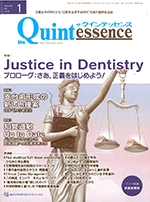
Author/Co-author : Tsutomu Sugaya, Toshihiko Tominaga, Hiroo Tarao, Hiromichi Kumagai, Atsushi Mori, Eiichiro Tada
When a high-frequency current is applied to a file with the Root ZX 3 high-frequency module (Morita Corporation: Fig. 1), heat is generated at the point of contact between the file and tissue, the soft tissue at the contact site is cauterized and evaporated, and 0.5 mm of the surrounding area undergoes thermal degeneration. In the area where the file is in contact with dentin, 1 second of current also cauterizes and evaporates the dentin, causing a depression of about 0.1 mm, and melting of the dentin in the surrounding 0.1 mm. These techniques were applied to a case of apical periodontitis in which inflammation did not improve with the conventional method, and good healing was achieved by cauterizing the granulation tissue in the root canal and bone defect. Furthermore, when the file was passed through the root canal, the electric current flowed to the root canal stenosis, side branches, and accessory root canals where the file did not reach, and Joule heat was generated there by the electric current, thus enabling pulp evaporation and thermal denaturation in the root canal stenosis and side branches as well as the main root canal in pulp extraction.
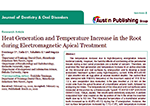
Authors and co-authors: Toshihiko Tominaga, Eiichiro Tada, Kazuki Takahira, Takeshi Sugaya
The temperature increase due to high-frequency energization reduces bacterial viability. However, the harmful effects of overheating of the periodontal tissues during a root canal procedure are a matter of concern. Therefore, we examined the heat generation and temperature increase in an active electrode on the intracanal and root surfaces by energization and to develop a novel endodontic treatment system using high-frequency current. K-file #10-40/.02 T was inserted into an egg white at several insertion depths. The current flow was energized with 510-kHz frequency at the maximum output of 15.5 W for 1.0s, and coagulation was evaluated. K-file was inserted at 2.0 mm on thecrown side from the apical foramen of a mandibular anterior tooth, followed byenergizing ten times. The temperatures of the intracanal and root surfaces weremeasured at the portion by a thermocouple Type-K TC-K-F-0.1-WP (HAYASHI DENKO Corp., Tokyo, Japan). The results were statistically analyzed. A uniform coagulated layer was created on the tip portion of the K-file when the insertion depth was up to 3.0 mm. The intracanal temperature of a mandibular anterior tooth increased up to 40.8℃-45.1℃ during the 1st energization. However, the root surface temperature increased by 7.1℃-7.8℃, with temperature increase per one energization being <0.5℃ if the time interval was >3.0 s during the subsequent energization. In the electromagnetic apical treatment system developed based on these results, the efficient generation of Joule heat and energization were possible without harmful effects on the periodontal tissue.

Author, Co-author : Toshihiko Tominaga, Koki Kitaike, Eiichiro Tada, Kazuki Takahira, Naoki Bando, Saki Hirao, Kunihiko Hayashi, Masanori Yokoyama, Hitoshi Yoshinaga
Disinfection of the root canal system is essential in endodontic therapy. However, due to the complex anatomical morphology, it is impossible to completely eliminate infecting microorganisms. We have reported that electromagnetic stimulation has an activating effect on osteoblastic cells as well as a bactericidal effect and suggested that direct electromagnetic stimulation may be applicable for refractory apical periodontitis. Consequently, we developed Electro-Magnetic Apical Treatment (EMAT), with the aim of promoting rapid healing of periodontal tissue. The purpose of this study was to assess the efficacy of EMAT for apical periodontitis. Methods:74 maxillary anterior teeth with periapical lesions (>5.0 mm in diameter) were treated. 37 teeth were stimulated by the EMAT device, and 37 teeth were not stimulated. Radiographic follow-up was performed to evaluate the healing effect at 12 months postoperatively. Results : The success rate (97.3%) in the EMAT group was statistically higher (p<0.01) than that in the non-stimulated group (73.0%). In the successful cases, the average reduction rate of periapical lesions was 9.7±5.2%/month in the EMAT group, which was significantly higher (p<0.01) compared with the non-stimulated group (4.9±1.7%/month). Conclusions : These results suggest that EMAT accelerates the healing process of periodontal tissue.

Authors and co-authors: Hiromichi Yumoto, Kouji Hirao, Toshihiko Tominaga, Naoki Bando, Kanako Takahashi, Takashi Matsuo
Periodontitis with bone resorption is caused by inflammatory reactions to bacterial infection. We recently reported that electromagnetic wave irradiation (EMWI) has bactericidal effects. However, the effects of EMWI on periodontal tissues remain unclear. This study was aimed to investigate the effects of EMWI on osteoblasts. Methods: Osteoblastic cells MC3T3-E1 were treated with EMWI (500-1,000 kHz, 5 times, 1 sec/time). Cell growth and cytotoxicity were determined by cell proliferation assays and measurement of lactate dehydrogenase release, respectively. Gene expression and protein production of growth factors were analyzed using real-time PCR and ELISA, respectively. EMWI-activated cellular signal transduction pathways were investigated by immunoblotting and blocking assay with specific inhibitors. Results: Osteoblasts proliferation was significantly enhanced 3 days after EMWI and no cytotoxicity was observed. EMWI up-regulated various growth factors, such as vascular endothelial growth factor (VEGF) and platelet-derived growth factor (PDGF). EMWI induced ERK1/2, p38 MAPK and SAPK/JNK phosphorylation within 5 min, and the production of PDGF-ΑΑ and VEGF was partially reduced by MAPK-specific inhibitor. Conclusion: These findings demonstrated that EMWI increases osteoblastic cell activity and the expression of growth factors via ERK1/2 and p38 MAPK pathways and suggested that EMWI may be beneficial to bone tissue repair such as periodontitis.

Authors and co-authors: H. Yumoto, T. Tominaga, K. Hirao, T. Kimura, K. Takahashi, T. Sumitomo, N. Bando and T. Matsuo
Aims: The aim of this work was to clarify the effects of electromagnetic waveirradiation (EMWI) on oral bacterial pathogens. Methods and Results: A Gram-negative (Porphyromonas gingivalis) or Grampositive(Streptococcus mutans, S. intermedius,Enterococcus faecalis) bacterial suspension was irradiated by EMW apparatus (500?1000 kHz, 5?15 times, 1s time)1). Quantification of survival bacteria by CFU counting revealed that EMWI exhibited marked bactericidal activity against all tested bacteria and bactericidal activity at 500 kHz increased in an irradiation number-dependent manner. After EMWI at 500 kHz, scanning electron microscopic observations showed that the chain of S. mutans cells was shortened after 5 irradiations and the outlines of bacterial cells (S. mutans and P. gingivalis) were unclear after 5? 10 irradiations. EMWI inhibited the inductive effect of S. mutans on proinflammatory cytokine production in human monocytes and this inhibitory effect was comparable with that of heat-killed bacteria. Furthermore, using an enzyme activity assay, EMWI partially inactivated the activities of gingipains from P. gingivalis. Conclusions: These findings demonstrated that EMWI has inactivation and bactericidal activities against single microbial species among four kinds of oral pathogens. Significance and Impact of the Study: Electromagnetic wave irradiation may be applicable for medical disinfection and sterilization, such as refractory periapical periodontitis.

Author/Co-author: Naoki Bando, Toshihiko Tominaga, Hiromichi Yumoto, Takashi Sumitomo, Saki Hirao, Koji Hirao, Takashi Matsuo
Periapical periodontitis is considered to be caused by infectious agents persisting in the root canal system triggering the host immune reaction. Disinfection is the key point for endodontic treatment, but it is difficult to completely remove all causal agents from the root canal system because of the morphological complexities. In this study, we focused on the potential usefulness of electro-magnetic wave irradiation (EMWI) for clinical application to promote healing. The aims of this study were : 1) to determine the characteristics of EMW and 2) to evaluate the clinical application of EMWI to endodontic treatment. The analysis of EMW characteristics demonstrated that it is important to make the diameter of the active electrode tip smaller and to keep the insertion depth within 5 mm for effective generation of Joule heat, and revealed that Joule heat conduction spreads 1.0-1.5 mm wide in the horizontal direction. The success rate of clinical application of EMWI was 99.1%, which is higher than that of the EMWI-untreated group (95.1%). Moreover, the reduction rate of the diameter of periapical lesion in the EMWI-treated group (75.62%) was significantly increased. These findings demonstrate that EMWI accelerates healing of periapical lesions and suggest that it may be useful for clinical application to refractory periapical periodontitis as non-surgical treatment.

Author/Co-author: Toshihiko Tominaga
Periapical periodontitis has been considered to be a host immune reaction triggered by infectious agents persisting in root canal system. Disinfection within the root canal system is the most important procedure in endodontic treatment; however, it is quite difficult to completely remove bacteria and all causal agents from the root canal system because of its anatomical and morphological complexities. Therefore, it is necessary to develop new control techniques against infected root canal-associated bacteria. Here, we focused on the potent of electro-magnetic wave irradiation (EMWI) as a disinfection apparatus against pathogens localized in the root canal as well as clinical application to promote the healing of bony defects around dental roots. The aims of this work were 1) to determine the characteristics of EMW, 2) to clarify the effects of EMWI on oral bacterial pathogens and 3) to evaluate the clinical application of EMWI to endodontic treatment. The analysis of EMW demonstrated that it is important to make the diameter of active electrode tip smaller and keep the insertion depth within 5 mm for effective generation of Joule heat, and revealed that Joule heat conduction spreads 1.0-1.5 mm wide in a horizontal direction, not vertical direction. Bacterial suspension was irradiated by the EMW apparatus (500-1,000 kHz, 5-15 times, 1 sec/time). The enumeration of survival bacteria revealed that the EMWI exhibited great bactericidal activity to kill all tested bacteria and this bactericidal activity at 500 kHz increased in an irradiation times-dependent manner. After 5-10 times EMWI at 500 kHz, scanning electron microscopic observations showed that a chain of Streptococcus mutans cells was shortened and the outer layer or shape of S. mutans and Porphyromonas gingivalis cells were unclear. EMWI inhibited the induction of pro-inflammatory cytokine production in human monocytes by S. mutans. Furthermore, EMWI partially inactivated the activity of gingipains from P. gingivalis. The success rate of EMAT clinical application was 99.0%, which is significantly higher than that of EMAT-untreated the control group (94.9%). Both the diameter and area of periapical lesion in EMAT group had markedly reduced throughout the entire follow-up period of 6 month. The changes per month in diameter and area of periapical lesion in EMAT group were much bigger than those in the control group. These findings demonstrated that EMWI has inactivative and bactericidal activities against oral bacteria and accelerates healing of periapical lesion, and suggest that it is useful for the clinical application to refractory periapical periodontitis as a non-surgical treatment.
Books and other materials

Author, Co-author: Toshihiko Tominaga, Eiichiro Tada, Kazuki Takahira, Tsutomu Sugaya
Book title: Infected Root Canal Treatment Retreatment: In Dr. Yoshifumi Kinomoto, editor (HYORON Publishers)
Excerpt from the first part of the book
Physical stimuli such as electromagnetic waves and ultrasound have been reported to promote healing, and high-frequency electric current may also promote healing of root apex lesions.
Therefore, we developed electromagnetic apical treatment (EMAT)(2~4), in which high-frequency current is applied directly to the root canal and periodontal tissue at the root apex to activate healing. This paper describes the EMAT technique and its clinical applications.
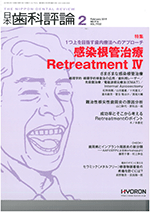
Author, Co-author: Toshihiko Tominaga, Eiichiro Tada, Kazuki Takahira, Tsutomu Sugaya
Title of book: Japanese Dental Review No. 916 (Japanese Dental Review)
Partial excerpt from the beginning of the book
Physical stimuli such as electromagnetic waves and ultrasound have been reported to promote healing, and high-frequency electric current may also promote healing of root apex lesions.
Therefore, we developed electromagnetic apical treatment (EMAT)(2~4), in which high-frequency current is applied directly to the root canal and periodontal tissue at the root apex to activate healing. This paper describes the EMAT technique and its clinical applications.
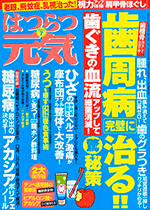
Author/Co-author: Toshihiko Tominaga
Book title: Hatsuratsu Genki July issue (Geibunsha)
Excerpt from the first part of the book
When alveolar bone dissolves, it is generally considered impossible to regenerate it, and surgical treatment or tooth extraction is the only option. In 2006, however, an epoch-making treatment that does not rely on either of these methods was born and has been attracting attention.
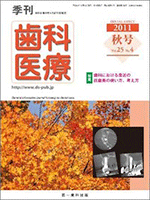
Author, Co-author: Toshihiko Tominaga
Book title: Dental Medicine Quarterly, Autumn issue (Daiichi Dental Publishing Co., Ltd.)
Partial excerpt from the first part
Electro-Magnetic Apical Treatment (EMAT), a direct application of electromagnetic waves, has been shown to inhibit recent growth and reduce the induction of inflammatory cytokine production in in vitro and in vivo studies.
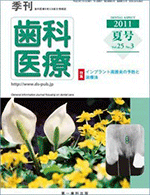
Author/Co-author: Toshihiko Tominaga
Book title: Quarterly Dental Care Summer Issue (Daiichi Dental Shuppan)
Excerpt from the first part of the book
Electro-Magnetic Apical Treatment (EMAT), invented in 2005, aims to accelerate periodontal tissue healing by directly applying electromagnetic waves (500~1000 kHz) to intractable root canal lesions to kill pathogens and activate osteoblast cells in and around the root canal.

Author/Co-author: Toshihiko Tominaga
Title of book: Dentistry Quarterly, Spring Issue (Daiichi Dentistry Publishing Co., Ltd.): New Treatment Methods to Preserve Natural Teeth
Excerpt from the first part of the book
Excerpt from the first part of the book
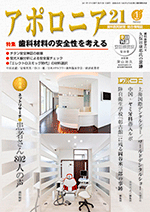
Published September 10, 2021 (Quintessence Publishing)
Authors and co-authors: Toshihiko Tominaga, Eiichiro Tada, Ryoichiro Takabi, Takeshi Sugaya
Partial excerpt from the beginning of the book
In this series of articles, we will discuss EMAT (electromagnetic bone regeneration therapy), which was invented in 2005 and has achieved good results in treating refractory radicular lesions that could only be treated by surgical procedures. In the third and final article in this series, we will review the history of the development of EMAT and look ahead to future developments.
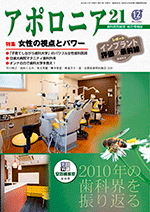
Author, Co-author: Toshihiko Tominaga
Book title: Apollonia 21: No. 204
Partial excerpt from the beginning of the book
This series of articles describes "EMAT (electromagnetic bone regeneration therapy)," which was invented in 2005 and has achieved good results in treating intractable root apex lesions that could only be treated surgically.
In this second article, we will introduce two cases in which EMAT was used in daily clinical practice to treat "refractory apical periodontitis" with persistent pain, swelling, and drainage of pus.
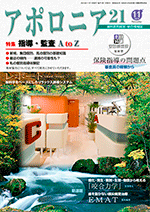
Author, Co-author: Toshihiko Tominaga
Book title: Apollonia 21: No. 203
Partial excerpt from the beginning of the book
In recent years, with the advent of microscopes and dental CTs, endodontic treatment is changing from a blind procedure to a more systematic treatment method. However, due to the complex anatomy of the root canal system, it is impossible to completely remove inflammatory factors by mechanical or chemical cleaning, and in daily clinical practice, we sometimes encounter cases that go untreated for a long time.
In this series of articles, we will introduce "EMAT (electromagnetic bone regeneration therapy)," which was invented in 2005 and has achieved good results in treating intractable root canal lesions that could only be treated by surgical procedures.

Author/Co-author: Toshihiko Tominaga
Book title: Tominaga Dental Booklet
Excerpt from the first part
It is very important for us to be able to "eat well". I have been a dentist for 20 years. I have always had a policy that I have always kept in mind....
"I will give my patients the medical care I want them to receive! No one wants to "grind teeth," right?
And I think "pulling teeth" is even worse.
I totally agree with you. I don't want to reduce my teeth because they will never grow back. There is nothing better than natural teeth. Can't I somehow keep these shaky teeth?" That's all I've been thinking about.
